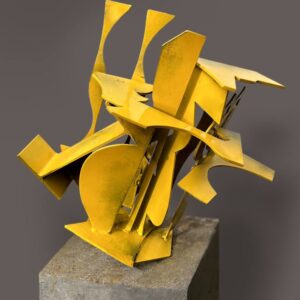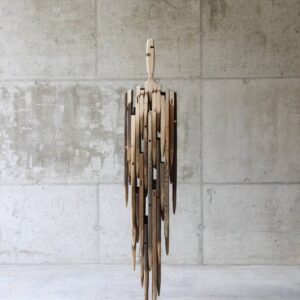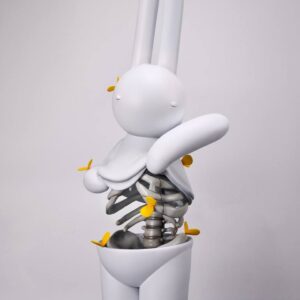How-To
Sculpture: A Beginner’s Guide to Collecting
Sculpture brings dimension, texture, and weight—both literally and visually—to a room. It can make a statement in an entryway or add quiet presence to a bookshelf. But collecting sculpture doesn’t have to feel intimidating.
From understanding materials to displaying works at home, this guide answers common questions about starting your sculpture collection with confidence.
Why collect sculpture?
There’s something elemental and experiential about sculpture. Unlike two-dimensional works, sculpture invites you to engage with its form, texture, and presence. You feel its weight, see the physical gestures embedded in the material, and respond to how it inhabits space.
For many collectors, sculpture opens the door to storytelling. Today’s artists use sculptural forms to explore everything from identity and memory to ecology and materiality, often incorporating unexpected objects or unconventional processes.
What should I consider before buying a sculpture?
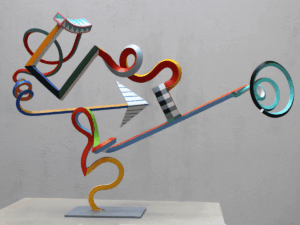
Featured Image: Sculptor Frans Muhren‘s Streamer 95
Start with your space.
Sculptures aren’t confined to walls. Consider where a work might live in your home and how it will interact with light, furniture, and movement. Do you need something that fits on a shelf, or are you looking for a freestanding piece that commands attention?
Learn about an artist’s practice.
Many collectors are drawn to sculpture because of the artist’s process. Is it hand-carved, cast in small editions, or made from reclaimed materials? Understanding the story behind the work adds to its meaning.
Think about the emotional impact.
Finally, consider how the piece makes you feel. Sculpture invites slow looking. A great piece will keep revealing something new from different angles and over time.
If you’re ready to dive in, browse our featured sculptures for a curator-approved, rotating selection of contemporary works in a variety of styles, sizes, and materials.
How do I choose the right material?
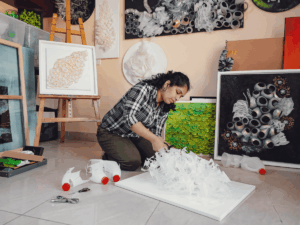
Featured Image: In the studio with eco-artist Swapna Namboodiri
The artist’s choice of material can shape the emotional and physical impact of a piece. In turn, each material lends a different feeling to a space:
Stone or marble: Durable, timeless, and ideal for both indoor and outdoor use. These materials convey permanence and weight. Keep in mind: stone is heavy and may require a sturdy base for display.
Bronze or metal: Sleek, modern, and weather-resistant. Bronze, stainless steel, and treated metals are excellent for outdoor placement. Untreated metals like iron may oxidize or patina over time—sometimes intentionally so.
Wood: Warm, organic, and full of natural character. Best kept indoors, as wood is sensitive to humidity and temperature changes. Occasional oiling can help preserve its finish.
Resin or mixed media: Lightweight and highly versatile. Resin is generally best for indoor use unless specially treated for outdoor display. Great for playful, colorful works and accessible price points.
These are just the starting points. Contemporary sculpture materials vary widely. Our digital exhibition, Sculpture, Today, reveals the many ways artists are pushing the boundaries of material for unexpected results.
Where should I display sculpture?

Featured Image: Natalya Seva‘s wall-mounted ceramics
A good rule of thumb is to give it room to breathe.
Unlike a two-dimensional canvas painting, sculpture plays with negative space. It changes depending on where you’re standing or how the light hits it. Think about sightlines and flow. A sculpture should feel integrated into your space, not wedged in.
Freestanding Sculptures
Corners and entryways: Perfect for tall or vertical pieces that can command a space without interruption.
Open-plan living rooms: Use a large sculpture to anchor a space or define a subtle divide between areas.
Outdoor gardens or patios: Place durable stone, bronze, or weather-treated sculptures where they can be viewed from multiple angles, surrounded by natural elements. Bonus tip: Always check the artist’s notes or ask our team whether a piece is rated for outdoor use. If you’re planning to install a sculpture on a patio, garden, or entryway, look for materials that are sealed or naturally weather-resistant.
Tabletop and Shelf-Size Works
Bookshelves and mantels: Ideal for smaller sculptures, ceramic vessels, or art objects.
Console tables and sideboards: Create layered displays with sculptural objects alongside framed art or mirrors.
Nightstands and dressers: Personalize your space with small, unexpected details.
Statement Pieces
Plinths and pedestals: Elevate a sculpture to eye level and give it space to stand out. This works well in corners, beside staircases, or as a centerpiece in a room.
Under a spotlight: Sculptures with reflective surfaces or rich textures respond beautifully to directional lighting. Consider adding a spotlight to highlight angles and shadow play.
In front of a neutral wall: Let bold or colorful forms pop against a clean backdrop, great for contemporary interiors.
Is it difficult to ship sculptures?
Our gallery makes it easy to shop a global selection of sculptures. When you collect, every artwork is packed and shipped with care. We handle customs paperwork, insurance, and delivery, so your artwork arrives safely, no matter the material or destination.
Still have questions? Talk to an Art Advisor for tailored suggestions.
